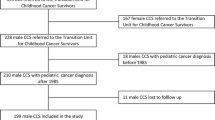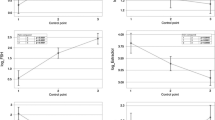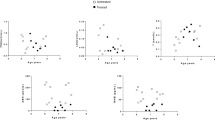Summary
Testicular and ovarian functions were assessed in 33 patients with Hodgkin's disease 1 to 17 years after cessation of COPP chemotherapy with cyclophosphamide, vincristine, procarbazine, prednisone. Diagnostic procedures consisted of hormone measurements, interviews, and semen analyses. In women serum levels of follicle-stimulating hormone (FSH), luteinizing hormone (LH), 17β-estradiol, progesterone, prolactin, and in men FSH, LH, 17β-estradiol, testosterone, and prolactin were determined. Semen analyses were performed in all men. Information concerning pregnancies, pregnancy outcome, future fertility wishes, sexual functions, menstrual pattern, and incidence of premature menopausal symptoms was ascertained by interview and questionnaire. Nineteen of 19 (100%) men showed elevated serum FSH levels between 715 and 1910 (median 1095) ng/ml and azoospermia, 1 to 11 years afters therapy. Serum levels of testosterone were within normal limits in 18/19 (95%) of the men, and LH values were normal in all men. Permanent ovarian failure occurred in 8/14 (57%) women, causing infertility and premature menopausal symptoms. The incidence of ovarian failure in women over 24 years was 86% (6/7) versus 28% (2/7) in those under 24 years at the time of treatment. In women receiving estrogen replacement, incidence and severity of these symptoms were significantly reduced. Of 14 women 3(21%) became pregnant and delivered 5 healthy children after treatment. Our results suggest irreversible sterility and normal Leydig cell function after COPP chemotherapy in all men. Druginduced ovarian failure was age-related and caused premature menopausal symptoms, detracting from the quality of the patient's life. To reduce premature menopausal symptoms and to prevent adverse cardiovascular and metabolic late sequelae, hormonal replacement is indicated. Pregnancies ending in normal live births can be achieved after COPP chemotherapy in young women. In both men and women, serum FSH and LH levels proved to be feasible markers to determine degree and duration of endocrine and reproductive gonadal injury after chemotherapy.
Similar content being viewed by others
References
Aitken JM, Hart DM, Lindsay R (1973) Oestrogen replacement therapy for prevention of osteoporosis after oophorectomy. Br Med J 3:515–518
Andrieu JM, Masson D, Fiet J, Gourmel B, Czyglik F, Bernhard J (1981) La fertilité des jeunes hommes atteints de la maladie de Hodgkin avant et après chimiothérapie. La Novelle Presse Médicale 10:2085–2088
Block E (1952) Quantitative morphological investigations of the follicular system in women. Variations at different ages. Acta Anat 14:108–123
Bonadonna G, Santoro A, Viviani S, Lombardi C, Ragni G (1984) Gonadal damage in Hodgkin's disease from cancer chemotherapeutic regimens. Arch Toxicol 7:140–145
Chapman RM, Sutcliffe SB, Malpas JS (1979) Cytotoxic-induced ovarian failure in women with Hodgkin's disease. JAMA 242:1877–1881
Chapman RM, Sutcliffe SB, Malpas JS (1981) Male gonadal dysfunction in Hodgkin's disease. A prospective study. J Am Med Assoc 245:1323–1328
DaCunha MF, Meistrich ML, Fuller LM, Cundiff JH, Hagemeister FB, Velasquez WS, McLaughlin P, Riggs SA, Cabanilas FF, Salvador PG (1984) Recovery of spermatogenesis after treatment for Hodgkin's disease: limiting dose of MOPP chemotherapy. J Clin Oncol 2:571–577
De Kretser DM, Burger HG, Hudson B (1974) The relationship between germinal cells and serum FSH levels in males with infertility. J Clin Endocrinol Metab 38:787–793
De Vita VT (1981) The consequences of the chemotherapy of Hodgkin's disease. The 10th David A. Karnofsky Memorial Lecture. Cancer 47:1–13
Greiner R (1982) Die Erholung der Spermatogenese nach fraktionierter, niedrig dosierter Bestrahlung der männlichen Gonaden. Strahlentherapie 158:342–355
Higano N, Robinson RW, Cohen WD (1963) Increased incidence of cardiovascular disease in castrated women. New Engl J Med 268:1123–1125
Holmes GE, Holmes FF (1978) Pregnancy outcome of patients treated for Hodgkin's disease. Cancer 41:1317–1322
Horning SJ, Hoppe RT, Kaplan HS, Rosenberg SA (1981) Female reproductive potential after treatment for Hodgkin's disease. N Engl J Med 304:1377–1382
Kreuser ED, Harsch U, Hetzel WD, Schreml W (1986a) Chronic gonadal toxicity in patients with testicular cancer after chemotherapy. Eur J Cancer Clin Oncol 22:289–294
Kreuser ED, Xiros N, Heit H, Hetzel WD, Hoelzer D (1986b) The effects on gonadal functions of intensified therapy in acute lymphoblastic and undifferentiated leukemia (ALL/AUL) in adults. Blut 53:243
Lauritzen C (1982) Das Klimakterium der Frau. Schering, Paris Frankfurt Berlin
LeFloch O, Donaldson SS, Kaplan HS (1976) Pregnancy following oophoropexy and total nodal irradiation in women with Hodgkin's disease. Cancer 38:2263–2268
McDonald P (1986) Estrogen plus progestin in postmenopausal women. Act II. N Engel J Med 315:959–961
Rister M, Müller AM, Gladtke E (1983) Kinder ehemaliger krebskranker Patienten. Dtsch Med Wschr 108:1137–1142 (1983)
Schilsky RL, Sherins RJ, Hubbard SM, Wesley MN, Young RC, DeVita VT (1981) Long-term follow-up of ovarian function in women treated with MOPP chemotherapy for Hodgkin's disease. Am J Med 71:552–556
Schütte B (1984) Hodenbiopsie bei Subfertilität. In: Schirren C, Holstein AF (Hrsg) Fortschritte der Andrologie, 9, Grosse, Berlin, S 166–167
Steeno OP (1983) The practicability of the “Nomenclature 1970”. In: Schirren C, Holstein AF (Hrsg) Diagnostic aspects in andrology. Fortschritt der Andrologie, 8. Grosse, Berlin, pp 55–58
Valaggussa P, Santoro A, Fossati-Bellani F, Banfi A, Bonadonna G (1986) Second acute leukemia and other malignancies following treatment for Hodgkin's disease. J Clin Oncol 4:830–837
Waxman JHX, Terry YA, Wrigley PFM, Malpas JS, Rees LH, Besser GM, Lister TA (1982) Gonadal dysfunctions in Hodgkin's disease: long term follow-up of chemotherapy. Br Med J 285:1612–1613
Whitehead E, Shalet SM, Blackledge G, Crowther D, Beardwell CG (1982) The effects of Hodgkin's disease and combination chemotherapy on gonadal function in the adult male. Cancer 49:418–422
Whitehead E, Shalet SM, Blackledge G, Crowther D, Beardwell CG (1983) The effect of combination chemotherapy on ovarian function in women treated for Hodkgin's disease. Cancer 52:988–993
WHO (1979) Handbook for reporting results of cancer treatment. WHO Offset Publication 48, Geneva, 14–21
Wuest JH, Dry ThJ, Edwards JE (1953) The degree of coronary atherosclerosis in bilaterally oophorectomized women. Circulation 7:801–809
Author information
Authors and Affiliations
Additional information
Supported in part by a grant from Deutsche Krebshilfe (M16/86 He 3)
Rights and permissions
About this article
Cite this article
Kreuser, E.D., Xiros, N., Hetzel, W.D. et al. Reproductive and endocrine gonadal capacity in patients treated with COPP chemotherapy for Hodgkin's disease. J Cancer Res Clin Oncol 113, 260–266 (1987). https://doi.org/10.1007/BF00396383
Received:
Accepted:
Issue Date:
DOI: https://doi.org/10.1007/BF00396383




